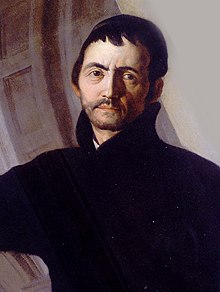Andrea Pozzo
| Brother Andrea Pozzo, S.J. | |
|---|---|

A self-portrait (17th century)
|
|
| Born |
30 November 1642 Trento, County of Tyrol, Holy Roman Empire |
| Died | 31 August 1709 (aged 66) Vienna, Habsburg Monarchy, Holy Roman Empire |
| Nationality | Italian |
| Education | Palma il Giovane, Andrea Sacchi |
| Known for | Architecture, painting, decorator |
| Notable work |
|
|
|
|
|
|
Andrea Pozzo (Italian: [anˈdrɛa ˈpottso]; Latinized version: Andreas Puteus; 30 November 1642 – 31 August 1709) was an Italian Jesuit Brother, Baroque painter and architect, decorator, stage designer, and art theoretician.
Pozzo was best known for his grandiose frescoes using illusionistic technique called quadratura, in which architecture and fancy are intermixed. His masterpiece is the nave ceiling of the Church of Sant'Ignazio in Rome. Through his techniques, he has become one of the most remarkable figures of the Baroque period. He is also noted for the architectural plans of the Ljubljana Cathedral (1700), inspired by the designs of the Jesuit churches Il Gesù and S. Ignazio in Rome.
Born in Trento (then under Austrian rule), he did his Humanities at the local Jesuit High School. Showing artistic inclinations he was sent by his father to work with an artist; Pozzo was then 17 years old (in 1659). From aspects of his early style this initial artistic training came probably from Palma il Giovane. After three years he passed under the guidance of another unidentified painter from the workshop of Andrea Sacchi who appears to have taught him the techniques of Roman High Baroque. He would later travel to Como and Milan.
On 25 December 1665, he entered the Jesuit Order as a lay brother. In 1668, he was assigned to the Casa Professa of San Fidele in Milan, where his festival decorations in honour of Francis Borgia recently canonised (1671) met general approval. He continued artistic training in Genoa and Venice. His early paintings attest the influence of the Lombard School : rich colour, graphic chiaroscuro. When he painted in Genoa the Life of Jesus for the Congregazione de' Mercanti, he was undoubtedly inspired by Peter Paul Rubens.
...
Wikipedia
